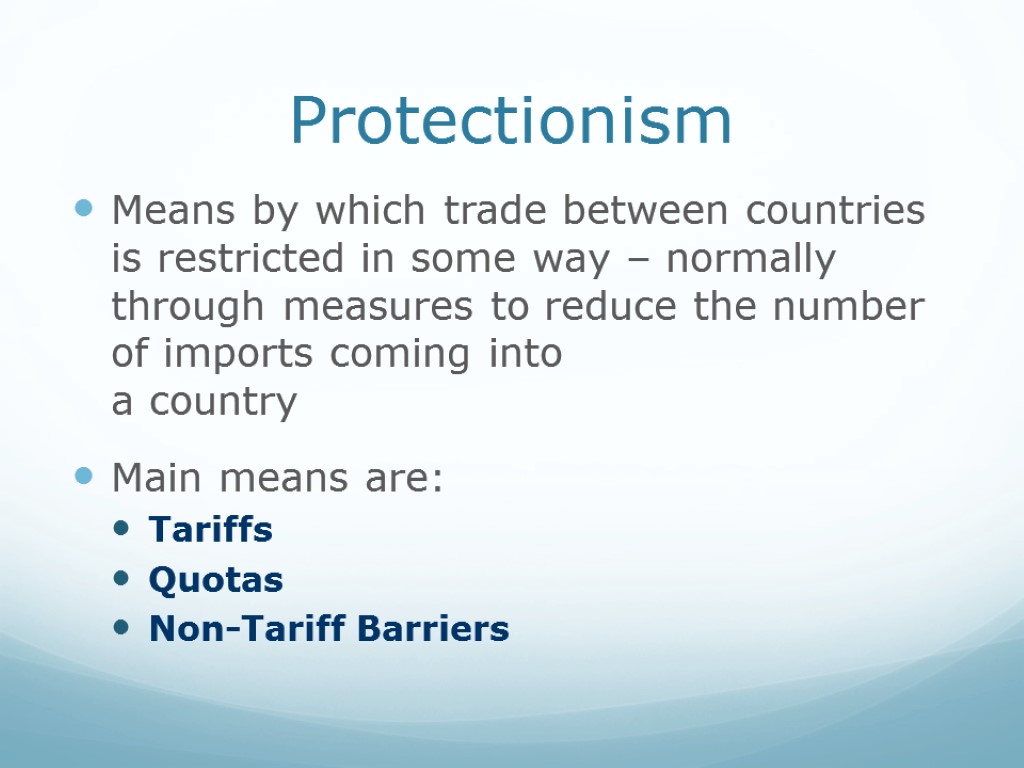Free trade and its benefits Kirill Perekrestov University


Free trade and its benefits Kirill Perekrestov University of Toronto [email protected] July 19, 2016 Toronto, Canada

Outline Introduction: Warm-up Protectionism explanation Non-Tariff Barriers Reasons for NTB Trade liberalisation explanation Free trade framework Potential benefits References Q&A

Warm-up Free trade is a policy which does not restrict imports from, or exports to, other countries. (1976, Brooks) Protectionism is the economic policy of restraining trade between countries through methods such as tariffs on imported goods, restrictive quotas (1976, Brooks)

Protectionism and Free Trade

Protectionism

Protectionism Means by which trade between countries is restricted in some way – normally through measures to reduce the number of imports coming into a country Main means are: Tariffs Quotas Non-Tariff Barriers

Protectionism Tariff: A tax on a good coming into a country (1983, Price) Quota: Physical restriction on the number of goods coming into a country (1983, Price)

Impact of a Tariff on Steel Price of Steel (US $ per kg) Quantity of Steel Bought and Sold from Abroad S D 20 S + Tariff Amount of the tariff per unit 500 28 350

Impact of a Quota on Steel Price of Steel (US $ per Kg) Quantity of Steel Bought and Sold from Abroad S D 20 500 Pre-trade position before a quota. Quota level 250 30 The quota restricts the supply to a set amount (250 in the example) which is likely to result in a shortage of this good and a subsequent rise in its price.

A price of the good increases and makes it less competitive RESULTS

Non-Tariff Barriers Any methods not covered by a tariff or quota, most usually: Rules Regulations Voluntary Export Restraints (VERs) Legislation Exacting Standards or Specifications

Non-Tariff Barriers Goal is not to prevent trade but to make the costs much higher Examples include setting exacting standards on fuel emissions from cars, the documentation required to be able to sell drugs in different countries, the ingredients in products – some of which may be banned in the destination country

Reasons Protect domestic industries Protect domestic employment Strategic reasons Political pressures Prevent ‘Dumping’ – selling goods in the destination country below cost to break into that market (1987, Mactavish)

Trade Liberalisation Aims to free up world trade and break down the barriers to international trade Basic philosophy rests on the principle of comparative advantage (produce sth at the lowest cost) Talks to achieve trade liberalisation have been ongoing for many years

Free trade framework GATT – General Agreement on Tariffs and Trade First signed in 1947 – talks on-going since then! Uruguay Round 1994 – set up the World Trade Organisation (WTO) as well as agreements covering a range of trade liberalisation measures WTO provides the forum through which trade issues can be negotiated and works to help implement and police trade agreements https://www.youtube.com/watch?v=6CPOhDZSHLI

Potential benefits Promotes international specialisation and increases world output Promotes efficient use and allocation of world resources Allows developing countries access to the heavily protected markets of the developed world thus helping promote development Facilitates the working of the international market system

Trade Liberalisation

References Baier, Scott L. and Jeffrey H. Bergstrand, 2004, "Economic Determinants of Free Trade Agreements," Journal of International Economics, 64(1), p. 29-63. Arkolakis, Costas, Arnaud Costinot and Andrés RodrÍguez-Clare, 2012, "New Trade Models, Same Old Gains?" American Economic Review 102(1), 2012: 94-130. Broda, Christian and David E Weinstein, 2006, "Globalization and the Gains from Variety," The Quarterly Journal of Economics, 121(2), p.541-85.

Thank you [email protected]
presentation_free_trade.ppt
- Количество слайдов: 19

